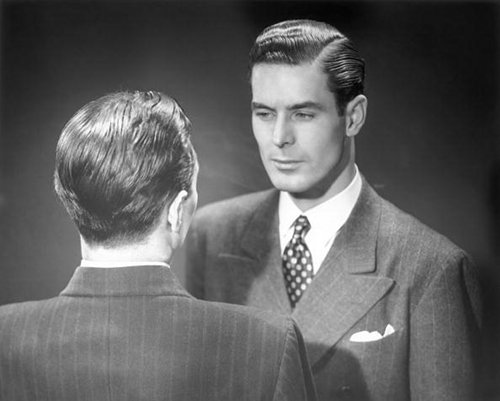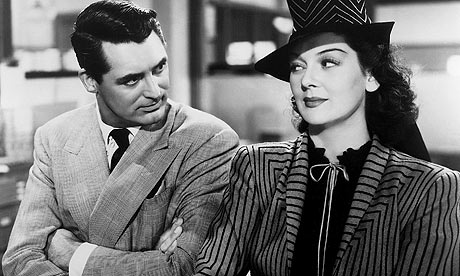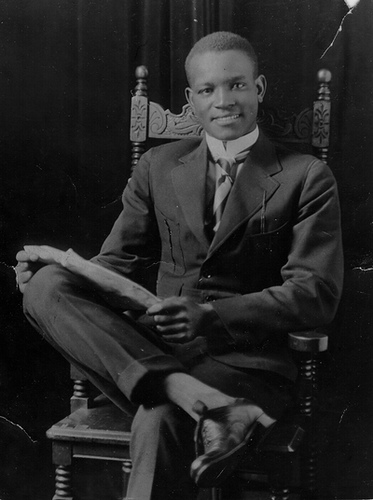
How often have you talked with another guy who never looked you in the eye during the entire length of the conversation? Or perhaps he did meet your gaze a few times, but then his eyes shifted back to his shoes or to some point off in the distance.
I’d like to say that the ability to make good eye contact is one of the social skills a lot of young men seem to be struggling with these days, which would be true, but I’ve encountered enough gaze-averting middle-aged men to know that it’s a multi-generational problem. And actually, it’s probably something men have always struggled with—females are on average better at making and holding eye contact than males, and in fact, it’s been found that the higher the levels of testosterone a fetus is exposed to in utero, the less eye contact they make as infants—across genders. Interestingly, the exception to this rule are male babies who have the very highest levels of T; they end up being as adept at eye contact as their female counterparts—alpha babies aren’t afraid to look you in the eye!
But just because making eye contact doesn’t come naturally to us men, doesn’t mean you should just shrug your shoulders and accept this predisposition. The ability to make high-level eye contact is a skill every man should work on, as it has been shown to create some incredible benefits for the gazer. Numerous studies have shown that people who make higher-levels of eye contact with others are perceived as being:
- More dominant and powerful
- More warm and personable
- More attractive and likeable
- More qualified, skilled, competent, and valuable
- More trustworthy, honest, and sincere
- More confident and emotionally stable
And not only does increased eye contact make you seem more appealing in pretty much every way to those you interact with, it also improves the quality of that interaction. Eye contact imparts a sense of intimacy to your exchanges, and leaves the receiver of your gaze feeling more positive about your interaction and connected to you.
In short, making greater eye contact with others can increase the quality of all of your face-to-face interactions; there’s no area of your life where being seen as more attractive, confident, and trustworthy wouldn’t be a boon. Being able to look people in the eye and hold their gaze can help you better network with others, land a job, pitch an idea, make a moving speech, woo the ladies, and intimidate your enemies. It can help a lawyer win over a jury, a boxer psych out his opponent, and a minister connect with his congregants. It can even aid a musician in winning over new fans; studies have shown that the more eye contact a musician makes with his audience, the more they enjoy his music—take note ye members of struggling bands!
And the best part of all this is that improving your eye contact is something you can do relatively quickly and easily. Next week in the second article of this two-part series, we’ll cover all the practical nuts and bolts on how to do that, and offer some really helpful eye contact tips for both general conversational situations as well as specific scenarios.
But today we’d like to begin with an exploration of why making eye contact is so important in forming relationships with other people, and why it can be so hard to do.
Why Eye Contact Is Vitally Important for Creating Positive Connections with Others
Why does making eye contact with people have such a dramatic effect in improving their perception of you? There are four main reasons:
1. Our eyes were made to connect. It’s easy to see why the eyes of others capture our gaze: they’re free-moving orbs lodged in an otherwise stationary face; eyeballs are really kind of weird when you think about them, aren’t they? But they also grab our attention for a reason that is distinctly human. While our irises and pupils float on a bright white canvas, none of the other 220 species of primates have white in their eyes at all, or at least whites that can readily be seen.
The whites of our eyes make it very easy for others to see exactly what we’re looking at and notice when our focus changes direction. While primates will typically turn their gaze in the direction a person points his whole head towards, a human infant is more likely to follow the person’s eyes, regardless of which way the person’s head is tilted. Anthropologists think our uniquely human eyes evolved to help us achieve a greater level of cooperation with others, which is helpful in survival and building a civilization. All of which is to say: your eyes were made to communicate with the eyes of other people.
2. Our eyes reveal our thoughts and feelings. You’ve probably heard the old expression: “The eyes are the window to the soul.†While that may not be literally true, they do reveal a great deal about what we’re really thinking and feeling from moment to moment.
Think of all the eye-related expressions we have in our language. We’re seduced by “bedroom eyes,†wary of “shifty eyes,†and afraid of getting the “evil eye.†We’re attracted to people who have “kind eyes†and eyes that “sparkle,†“glow,†or “twinkle,†while we’re repelled by those who are “dead behind the eyes.†When someone is eager and peppy we say they’re “bright-eyed;†when they’re bored we describe their eyes as “glazed over.†Love stories in both fiction and real life very often begin with two pairs of eyes meeting across a room. And Bryan Adams says you can gauge your love for a woman from your ability to see your unborn children in her eyes! Kind of romantic, kind of creepy.
That we give so much credence to the idea that we can read someone from what’s in their eyes is due to the fact that even when we hide what we’re really thinking and feeling in our body language and facial expressions, it’s often still revealed in our eyes. “The eyes don’t lie†as people say (although good liars can, in reality, get their eyes to fib for them). This is why poker players often wear sunglasses in order to disguise their reactions to the hands they’re dealt.
The human propensity to look to someone’s eyes in order to decipher what they’re thinking starts very early in life. Around 9-18 months, infants will begin to look to their parents’ eyes to figure out what they’re trying to convey when their face is otherwise ambiguous. And we continue to do this for the rest of our lives.
Finally, we lend a lot of weight to eye contact in our interactions because it’s a form of simultaneous communication. You don’t have to take turns expressing yourselves as you do with talking. If you’ve ever had a whole mini conversation across the room with your spouse, using only your eyes, you know how this works.
3. Eye contact shows attention. Sociologists tell us that people are starved for attention these days. Despite the fact that we’re more “connected†than ever, folks are hungry for face-to-face interactions and someone to really, sincerely listen to them. This hunger for attention can manifest itself in things like “conversational narcissism.†And if you read our discussion about that social malady from awhile back, you’ll remember that we talked about how you show your attention to someone with whom you are talking by using “support-responses,†such as nodding your head and offering “background acknowledgments†like “mmm’s†and “yeah’s.†Well, eye contact is another form of background acknowledgement—and a very important one at that. It shows the speaker that you’re tuned in to what he’s saying. Think of how crappy you feel when you’re talking with someone and he’s looking all around the room for someone else to ditch you for.
The ability to give eye contact to someone as they speak is an especially powerful tool these days; it has become so common for people to break their gaze to check their phone during a conversation, that giving someone your complete and undivided attention can truly win them over.
4. Eye contact creates an intimate bond. When I am performing a task or feeling an emotion, and you are observing me do so, the same neurons that are being lit up in my brain by actually having the experience, are the ones that light up in your brain just from watching me. This is made possible by the presence of “mirror neurons†in our craniums. And the activation of these mirror neurons is especially sensitive to facial expressions, and, you guessed it, eye contact. Have you ever been hit hard with an emotion after looking into the eyes of someone who was experiencing it? Eye contact creates moments where you are able to really feel what someone else is feeling. It links together your emotional states and creates empathy and an intimate bond.
This is why when we’re interacting as disembodied selves on the internet, it can be very easy to be angry and hateful to people, but when you see someone face-to-face, and look into their eyes, you often can get a sense of their humanity and your anger greatly dissipates.
Getting in-sync with others, sharing our feelings, showing attention, creating a bond: eye contact is truly a powerful tool for connecting with others.
Why Is It So Hard to Make Eye Contact?

But on the other hand…getting in-sync with others, sharing our feelings, showing attention, creating a bond…these things aren’t easy—especially for men!
While people like to see our eyes so they can get a handle on what we’re really thinking and feeling, from our side of things, revealing what’s going on inside our heads can make us feel very vulnerable. We avoid eye contact when we don’t want people to take a closer look at us and see more of who we are. This reticence can be rooted in several causes:
Hiding deceit. If you’re purposefully hiding the truth from someone, you may hesitate to look them in the eye because you’re worried that your eyes will give away the truth, and because creating the kind of intimate bond described above when you’re knowingly duping someone makes you feel especially ashamed. This is why people will sometimes, although not always, avoid your gaze when they’re lying to you, why people say things like: “Look me in the eye when you tell me that!†and why people who do make solid eye contact are considered more trustworthy.
Masking emotions. There are times when you’re not trying to disguise a lie outright, but simply wish to conceal your true feelings from others, such as when you do not think your reaction to something will be received favorably by them. Anger, fear, and surprise are the emotions that register most through our eyes, and are hardest to hide. And they’re also the emotions we most often want to keep from others.
Insecurity. Finally, one of the most common reasons that people avoid eye contact is from simple insecurity. Eye contact invites more interaction, and you might not want people to take a closer look at you because of how you feel about yourself.
People with higher-status make more eye contact when they’re speaking to others, while those who feel they are of lower-status will make less eye contact and be the first to avert their gaze. When a guy can’t look anyone in the eye when he’s speaking to them, it’s often because he doesn’t feel like he comes up to anyone’s level; he doesn’t believe he can hold his own with other people.
This lack of confidence can be rooted in insecurity over one’s physical appearance, or the state of one’s mind. A study was done where college students were shown faces which looked at the participants with different kinds of gazes—averted or direct. The students then ranked the faces on whether they seemed approachable or avoidable. Then a survey was given to the participants that evaluated their mental health. The students who ranked the faces that had a direct gaze as approachable were found to be more emotionally stable than those who found the direct gaze faces avoidable. Another study specifically showed that people who suffer from depression—which can do a number on a person’s self-confidence–are less likely to make eye contact with people.
People will also avoid eye contact when saying a sarcastic, as opposed to a sincere, comment, as sarcasm is often used by those who are too insecure to show aggression or state their opinion directly.
The Best Way to Improve the Quality of Your Eye Contact

The common denominator in all three of the above reasons for avoiding eye contact is the fear of rejection. If eyes are the portals to our feelings and thoughts, eye contact acts as an intimacy regulator. The more eye contact you make, the more you put yourself out there. Thus the more confidence you have in what people will find once they get a closer look at you and peer into the chamber of your heart, the more comfortable you feel with looking them in the eye. And conversely, the more shame you feel about what others will discover when you open up to them, the more likely you are to avert your gaze.
As I mentioned, next week we’ll get into the practical nuts and bolts of how to make eye contact in the right way. But it should be obvious from this introduction that no amount of external fine tuning of your gaze can compensate for unresolved internal issues that need fixing. You can force yourself to make eye contact with people even when you don’t feel like it, but good eye contact is not just about quantity, it’s about quality. While it may not be true that the eyes are the window of the soul, in my opinion there really is something almost metaphysical about the way in which our character becomes etched upon them. People with kind eyes are almost invariably kind people. People with a twinkle in their eyes are almost always possessed with an enviable vitality. And those with dead eyes on the outside, tend to be dead on the inside, too.
Thus the foundation of good eye contact truly comes from within (changing your outer appearance by doing things like losing weight and dressing your best helps too, but even these things typically require a change of inner attitude). The more you live a life of integrity, the easier it will be to look everyone you meet in the eye, and do it with confidence and a real smile.
Read Part II: How to Make Eye Contact the Right Way
Note: The principles in this series are written for men who live in Western countries. The importance of eye contact and how to make it can vary from culture to culture.
Be sure to check out our podcast on the importance of face-to-face communication:
Sources:
The Power of Eye Contact: Your Secret for Success in Business, Love, and Life by Michael Ellsberg
The Persuasion Handbook: Developments in Theory and Practice by James Price Dillard, Michael Pfau
Applied Organizational Communication: Theory and Practice by Thomas E. Harris, Thomas E. Harris, and Mark D. Nelson
Nonverbal Communication by Albert Mehrabian
Status and Groups by Melissa Thomas-Hunt



